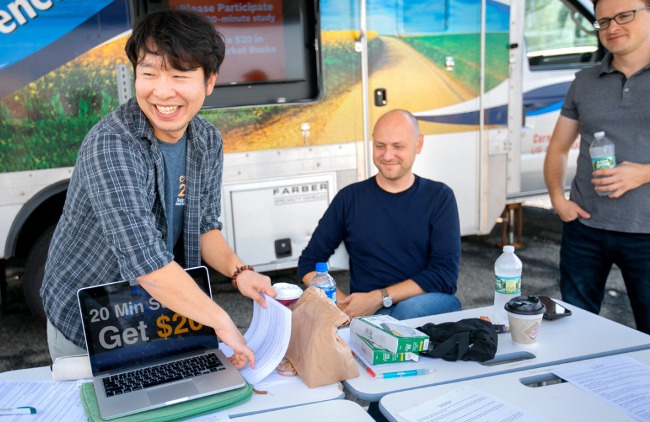Communications of the ACM
RV Mobile Lab Broadens the Pool of Research Participants

Cornell University's RV mobile lab aids the Department of Communication's outreach mission.
Credit: Cornell University
A New York City-based mobile communication lab is enabling researchers to diversify their pool of study participants to include those rarely surveyed and hardest hit by society's problems.
Shoppers browsing the freshly dug onions and dusky plums at the farmer's market in Staten Island, New York, recently found an unusual offering: Cornell University researchers who want to know what they think about the air pollution right there in their own neighborhoods on Staten Island.
Over the course of the day, 70 Staten Islanders stepped up to what appeared to be a normal RV, where graduate student Byungdoo Kim asked if they'd like to participate in a 20-minute survey in exchange for $20 in farmers market vouchers.
The RV actually houses a mobile communication lab that's changing social sciences research at Cornell and beyond.
One of a handful in the United States, the mobile lab enables researchers to diversify their pool of study participants to include people in socio-economic, racial, and geographic groups who are rarely included in social science research.
"This lab really allows us to take research beyond the ivory tower," says Neil Lewis Jr., assistant professor of communication in the College of Agriculture and Life Sciences. "And it highlights a strength of Cornell as a place where any person can be in any study."
Scholars at other universities are taking notice, Lewis says. In academic circles, "everywhere I go now, in Chicago, in Seattle, this is the thing that people want to talk to me about," he says.
Paying Attention
The lab is fitted with eye-tracking equipment that enables researchers to trace the path of a person's eye movements and measure how long their eyes rest on a particular spot on the computer screen. That tells them what the person is paying attention to.
In Staten Island, participants sat at computers inside the RV and viewed digital maps, created by H. Oliver Gao, professor of civil and environmental engineering, showing the ebb and flow of air pollution on Staten Island and other boroughs in New York City at different times of day. With funding from Cornell's David R. Atkinson Center for a Sustainable Future, the researchers are hoping to understand whether the parts of the maps the participants pay attention to correlate with their environmental concerns and intentions to take a variety of environmentally friendly actions.
"It's a very good idea to have [the lab] here, because then you get to talk to the people who are living in the community, to find out their opinions," said a 32-year-old African-American woman who participated in the study. Her young son's asthma gets worse when air pollution levels are high, she said.
"One of the most exciting and innovative things we're doing here is studying how people respond to environmental hazard maps in the very place where they live and where those hazards are occurring," says Jonathon Schuldt, associate professor of communication.
Most psychophysiological research in higher education is done online or on campus with people most readily available to researchers: college students. "If that's all you study, it gives you a really narrow view of human behavior," Lewis says.
Several communication faculty members are considering using the lab for various pilot studies. Assistant professor Andrea Stevenson Won, for example, hopes to use the lab for research on virtual reality.
Seeing More
The lab came into being thanks to Sahara Byrne and Jeff Niederdeppe, both associate professors of communication. "It struck us that with a mobile lab, we could access populations that we don't often study, especially not with eye-tracking equipment," Byrne says.
In 2014, they won a grant from the National Institutes of Health and the U.S. Food and Drug Administration. It included funding for a lab and eye-tracking experiments with youth and adult smokers as they looked at graphic warning labels on cigarette packaging. The lab is also funded by the Colleges of Human Ecology and of Agriculture and Life Sciences.

So far, Byrne and Niederdeppe—with the help of Amelia Greiner Safi of the Department of Population Medicine and Diagnostic Sciences, who connected with community partners across New York State and beyond—have surveyed 5,000 rural upstate New Yorkers—2,500 adults and 2,500 youth. With that data, they've have written seven papers, some with constitutional law expert Michael Dorf, the Robert S. Stevens Professor of Law, and Alan Mathios and Rosemary Avery, both professors of policy analysis and management. For example, an upcoming study shows that graphic warning labels in cigarette ads capture more attention than text-only warnings.
Beyond the specific findings, Byrne and Niedereppe say the mobile lab has changed their research forever, by giving them a greater understanding of the challenges facing disadvantaged populations.
For example, Byrne learned that people struggling with drug addiction—who may have lost custody of their children or who can't keep a job because of addiction—may turn to cigarettes because they perceive tobacco will help them stay off drugs. "I think about those kinds of things now," Byrne says. "And I did not see that coming."
Perhaps most important, the study participants say they are grateful to be asked to share their opinions, the researchers say. In the smoking study, people stood in lines for up to two hours to participate.
"In the Bronx, they said, 'No one usually cares what we think,'" Lewis says. "For communities that are used to being unheard, it's a huge statement for us to even show up; it shows them that their voices matter."
No entries found